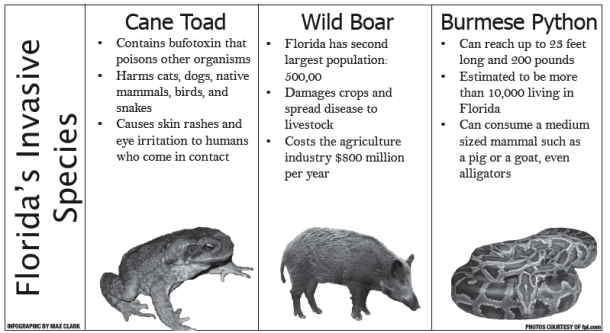South Floridians remember Hurricane Andrew as a horrific hurricane that caused billions of dollars of damage and destroyed thousands of homes. Hurricane Andrew was the fourth most powerful hurricane to make landfall in the U.S. in the twentieth century.
But Andrew’s ecological effects on South Florida, especially the Florida Everglades, might be much more severe than initially thought. Scientists recently realized that Hurricane Andrew might have begun a hidden environmental disaster currently ravaging the Everglades: the invasion of the Burmese python, a large snake native to the tropical rainforests of Southeast Asia.
One theory that explains this invasion is that the snakes escaped during Hurricane Andrew from zoos and households, where many people kept them as pets. The main danger associated with housing pets like Burmese pythons is their sheer size; when the snake grows too big for comfort, people often abandon them, and large snakes pose many dangers and can kill small children.
“Burmese pythons have no natural predators, so they compete with native species for resources,” Biology teacher Ann Nelson said.
The Burmese python is one of the six largest snakes in the world, reaching up to 23 feet long and weighing up to 200 pounds, about the size of a telephone pole. It is a voracious carnivore with the ability to hunt and consume a medium-sized mammal such as a pig or a goat. Burmese pythons thrive in warm weather and humid climates, perfect for its non-native South Florida.
As with any other invasive species, the Burmese python poses serious harm to the Everglades. It preys upon endangered animals such as alligators and birds; native animals have never lived in the same ecosystem as a Burmese python.
The pythons’ population growth worsens the problem. Scientists estimate that possibly tens of thousands of pythons already live in South Florida.
“Pythons are well-adapted to survival in the Everglades ecosystem because of the perfect weather and the abundance of food,” Nelson said.
In an attempt to decrease the python population, the Florida Fish and Wildlife Conservation Commission authorized a python-hunting season in the Everglades that took place between March 8 and April 17, 2010. Florida Senator Bill Nelson introduced SB 373 to the U.S. Senate, a bill that bans Burmese pythons from being imported into America as well as inter-state trade.
Global warming could also exacerbate the Burmese python population. If temperatures were to rise substantially across the U.S., especially in the South, Burmese pythons could extend their range northward, posing another threat to other parts of the country.
Invasive species also harm other parts of the country and even the world. Regardless of the location, they need to be controlled.
“We have to control them [invasive species] so that we can limit their effect on the population by capturing them,” senior Anil Salgar said.



